The two-state solution: A strategy to buy time for the Zionist regime
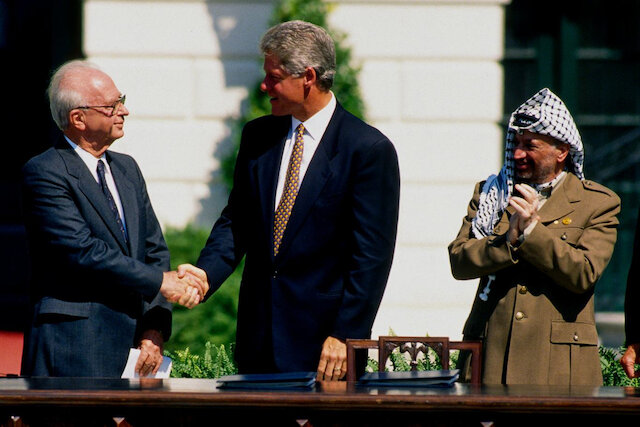
In the 1990s, with the Palestinian issue dragging on, Western countries, led by the United States, pushed for a two-state solution in the occupied Palestinian territories. As part of this effort, the Oslo Accords were signed in 1993 between the leaders of the Zionist regime and the Palestinian Liberation Organization (PLO). The Oslo Accords aimed to create a framework for the complete resolution of the Israeli-Palestinian conflict. However, the past 30 years have revealed that the promises of this agreement were unfulfilled, with the main outcomes being the Judaization of al-Quds and the expansion of Zionist settlements in the occupied Palestinian territories. Edward Said, a prominent advocate for the Palestinian cause and an early supporter of the two-state solution, eventually conceded that the plan was unworkable due to the Zionist regime’s policies on illegal settlements (Li 118). Recently, UN Secretary-General’s spokesman Stéphane Dujarric also described Israel’s actions as a “wrong step” in the context of the two-state solution.
The present text aims to inform the reader that the Zionist regime pursues only one goal: the establishment of a quasi-apartheid Zionist state in the occupied territories. The so-called two-state solution is merely a facade masking the regime’s shameless strategy in the region.
Actions of the Zionist regime in the Post-Oslo Accords era
Currently, the Palestinian areas in the occupied territories include the West Bank, administered by the Palestinian Liberation Organization (PLO), and Gaza, controlled by the Hamas government. Examining the actions of the Zionist regime since the Oslo Accords, it is evident that this regime has never been willing to accept the two-state solution. The strategy of the Zionist leaders was to first gain legitimacy from some Palestinian leaders, Arab countries, and positive public opinion at that time (late 1980s and early 1990s), and then to buy time to seize and annex more territories. In this context, Map No. 1 shows that even the West Bank, an area where some Palestinians sought peace and legitimacy for the Zionist regime, has never been handed over to the Palestinian Authority as was supposed to happen under the Oslo Accords and the two-state solution.
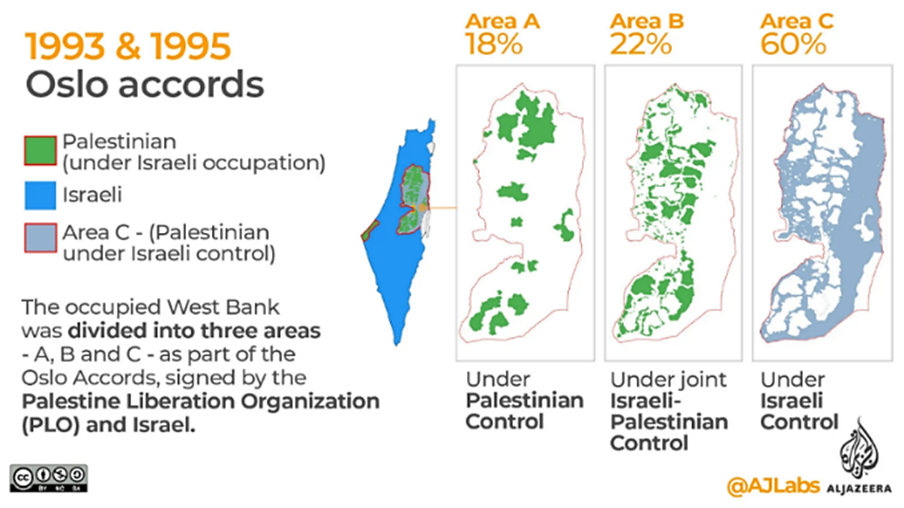
One of the methods the Zionist regime has used to colonize areas of the West Bank is expanding settlements and implementing policies to increase and relocate the Jewish population in the region. According to a United Nations report on March 28, 2023, the illegal settler population now exceeds 700,000, compared to over 250,000 in 1993. Another tactic employed by the Zionist regime to take over occupied territories is to declare lands as state-owned under various pretexts. For instance, The Huffington Post reports that, according to an official document, the Israeli government approved the seizure of 1,270 hectares of land near the Jordan Valley, an unprecedented move since the Oslo Accords. Additionally, Le Monde reports that in the first six months of 2024, according to data from the organization “Peace Now,” 2,370 hectares of land were declared “state land” by Israeli authorities, allowing them to lease these lands exclusively to settlers.
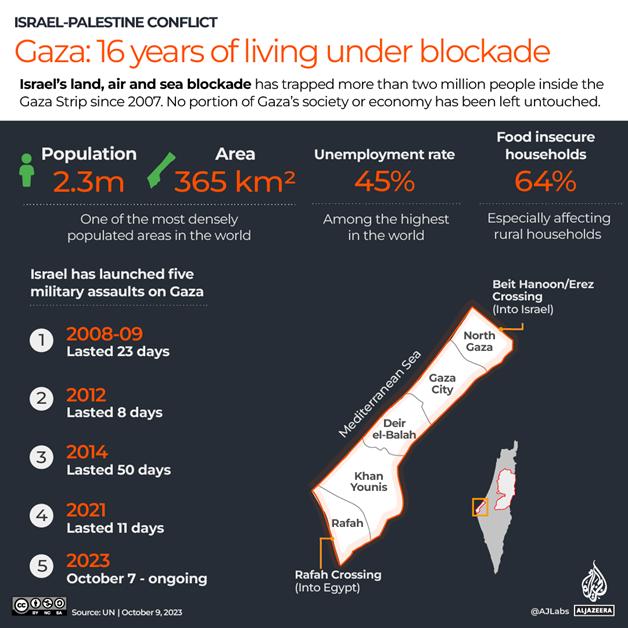
In Gaza, which has been resisting the oppression of the Zionist regime, the regime’s approach is different. Since 2007, the Zionist regime has turned Gaza into the world’s largest open-air prison, depriving its people of the most basic human rights. This involves implementing apartheid policies aimed at forcing the population to migrate to other countries. Map No. 2 shows that from 2007 to 2023, the Zionist regime has launched five military attacks on Gaza.
The 2023 war is fundamentally different from the previous four attacks because it is being conducted under the “Dahiya Doctrine,” which aims to forcibly displace the people of Gaza, leaving the area depopulated for easy acquisition by the Zionist government. The Dahiya Doctrine refers to a military strategy in asymmetric urban warfare where the army deliberately targets civilian infrastructure to increase deterrence by putting additional pressure on civilians and causing them greater suffering. As of the writing of this report, more than nine months into the war, some sources estimate the death toll to be 40,000, while others, such as The Lancet medical journal, report over 186,000 indirect deaths. Regarding infrastructure, satellite images in the United Nations’ latest report on May 31, 2024, indicate that 55% of Gaza’s infrastructure has been destroyed (Map No. 3), and nearly 65% of the entire road network across the Gaza Strip has been obliterated (Map No. 4).
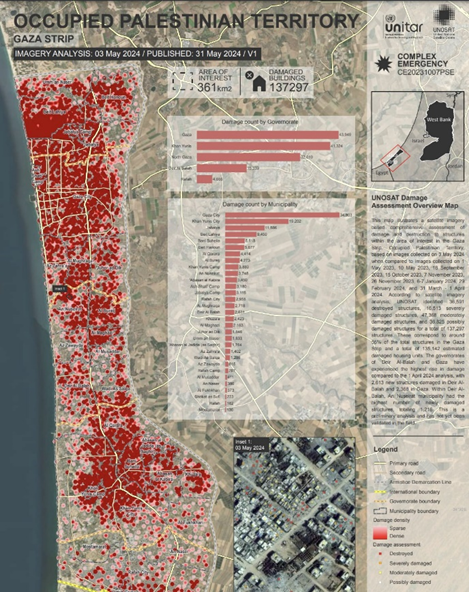
Source:
https://x.com/UNOSAT/status/1797523937049637136/photo/1
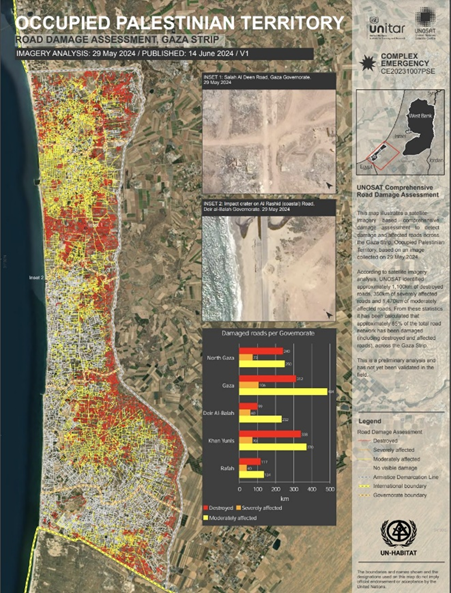
Source:
https://x.com/UNOSAT/status/1801643733298872659/photo/1
The two-state solution: A strategy to buy time
As decades have passed since the Oslo Accords and the proposal of the two-state solution, it becomes evident that despite the adoption of UN General Assembly Resolution 181, also known as the Partition Plan for Palestine, on November 29, 1947, the Zionist regime encountered a legitimacy crisis in the global community by the late 1980s. Consequently, it pursued a new strategy to exploit the remaining Palestinian territories, unlike during the previous conflicts of 1948 (War of Independence), 1967 (Six-Day War), and 1973 (Yom Kippur War), which had led to internal war fatigue and diminished support from Western nations due to the Arab oil embargo and subsequent economic crisis impacting Western economies. Thus, the two-state solution has functioned as a tool for the Zionist regime to prolong and advance its goals, albeit betraying the Palestinian cause. It is noteworthy that today, Zionist leaders have sought to advance this agenda through initiatives like the Abraham Accords to achieve broader objectives, although the “Al-Aqsa Flood Operation” prematurely disrupted this new framework. As articulated by Imam Khamenei in his June 3, 2024 speech:
Operation Al-Aqsa Flood took place precisely at a time when the region needed it, the explanation for this is that a comprehensive, broad plan had been devised by the US, Zionist elements, their followers, and certain governments in the region. This comprehensive plan aimed to reshape regional relations and dynamics. [The goal was to] establish relations between the Zionist regime and regional governments based on the wishes of that regime. This in turn meant that the Zionist regime would not only attain domination over the politics and economy of the entire region of West Asia, but also over the entire Islamic world.
Anyone impartial, without national or religious biases, who wishes to delve into the Palestinian issue will understand that the sole path to achieving peace and enduring stability in the occupied territories lies in conducting a referendum in Palestine, inclusive of all ethnic groups and religions. On May 1, 2024, Imam Khamenei articulated:
The problem will only be solved when Palestine is returned to its rightful owners — that is, the Palestinian people. Palestine belongs to the Palestinians, among whom are Muslims, Christians, and Jews. Palestine … must be returned to them. They have the right to form their own government and system, which can then decide how to deal with the Zionists. Whether they will expel the Zionists or allow them to stay should be their decision to make. This is the solution we proposed several years ago. … The issue in West Asia will not be solved until this happens.
References:
Li, Yi. “Edward Said’s Thoughts and Palestinian Nationalism.” Journal of Middle Eastern and Islamic Studies, vol. 5, no. 3, 2011, pp. 105-120.
| © | KHAMENEI.IR |


